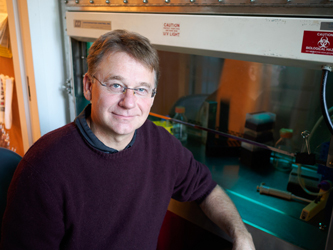Henk Roelink

Professor Emeritus of Genetics, Genomics, Evolution, and Development
Research Interests
The Roelink lab is interested in the mechanisms of embryonic induction, the phenomenon in which a group of cells changes the developmental fate of neighboring cells via the release of inducers. The molecular nature of these inducers is known and they belong to a relatively small number of families of signaling molecules. Invariably these molecules are involved both in the maintenance or differentiation of adult stem cells as well as in cancer. We are particularly interested in those inducers that are critical for neural tube patterning; Sonic Hedgehog (Shh) and members of the BMP and Wnt families. We are using both neuralized Embryonic Stem (ES) cells as well as chicken embryos to assess the effects of inducers and the molecules involved in their distribution, reception and intracellular signal transduction. We apply this knowledge to instruct embryonic stem cells to differentiate in vitro into desired cell types.Current Projects
The role of Disp1 in the distribution of Shh
Dispatched1 (Disp1) encodes a widely expressed twelve transmembrane domain protein with a putative sterol-sensing domain and is required for paracrine Sonic hedgehog (Shh) signaling. In the absence of Disp1 function, Shh is largely retained in Shh-producing cells, suggesting a role for Disp1 in the export of Shh and establishment of a long-range Shh gradient. The precise role of Disp1 in releasing lipid-modified Shh from Shh-expressing cells remains unclear, however, we envisage two possible Disp1 functions in Shh-expressing cells; the polarized trafficking of Shh or formation or release of soluble Shh complexes.
We derive neural tissues from ES cells, and take advantage of the many ES lines in existence with specific genetic defects, including those that do not have functional Disp1 genes. Using these cells we can both address the requirement for Disp1 in cells that express Shh, as well as in the cells that respond to Shh.
Effect of Shh binding molecules in the extra-cellular space on the range of Shh signaling
Since Shh has two membrane anchors, but nevertheless signal over a long range, it is no surprise that there are several molecules that bind Shh in the extracellular space and influence the range of Shh. We are investigating both the role of Heparan Sulfate Proteoglycans (HSPGs) and Hhip in Shh distribution. HSPGs are large molecules that occupy a significant fraction of the extracellular space, that bind many signaling molecules, including Shh. We are testing the ability of ES cells deficient for Ext1, which is required for Heparan Sulfate synthesis, to produce, release and respond to Shh.
Hhip is a transmembrane protein that binds Shh in attenuates the Shh response, presumably by preventing transport of Shh, or binding of Shh to its receptor. However, despite the presence of a transmembrane domain, Hhip is able to inhibit the Shh response several cell diameters away from where it is synthesized. This in turn implies that Hhip, despite the presence of a trans-membrane domain, is released from cells. We are very interested how Shh and Hhip, proteins expected to be membrane bound, still have effects several cell diameters away form their sites of synthesis.
Deriving specific neurons from ES cells
Selected Publications
Etheridge, L. Alton, T. Quinn Crawford, Shile Zhang and Henk Roelink. Evidence for a role of Disp1 in long-range Shh signaling. Development (2010) 137(1), 133-140.Bijlsma, M. F, M. P. Peppelenbosch, C. A. Spek & H. Roelink. Leukotriene synthesis is required for Hedgehog-dependent neurite projection in neuralized embryoid bodies but not for motorneuron differentiation. Stem Cells (2008) 26(5), 1138-1145
Crawford, T. Q, and H. Roelink. The Notch response inhibitor DAPT enhances neuronal differentiation in ES cell derived Embryoid Bodies independently of Shh signaling. Dev. Dyn. 236 (2007) 886-892
Braun M. M., A. Etheridge, A. Bernard, C. P. Robertson and H. Roelink. The zli is a Regional Organizer of the Diencephalon; Wnt is Required for Dorsal Thalamus Formation. Development, 30 (2003) 5579-5587
Meyer, N. P. and H. Roelink. The amino-terminal region of Gli3 antagonizes the Shh response and acts in dorsoventral fate specification in the developing spinal cord. Dev. Biol. 257 (2003) 343–355
Incardona, J. P., J. Grünberg and H. Roelink. Sonic hedgehog induces the segregation of patched and smoothened in endosomes. Curr. Biol. 12 (2002) 983-995
Incardona, J. P., J. H. Lee, C. P. Robertson, K. Enga, R. P. Kapur, and H. Roelink. Patched-1 Mediates the Intercellular Transfer and Endocytosis of Soluble and Membrane-tethered forms of Sonic hedgehog. Proc. Natl. Acad. Sci. USA 97 (2000) 21044-12049
Incardona, J. P., W. Gaffield, R. P. Kapur, H. Roelink. The Teratogenic Veratrum Alkaloid Cyclopamine Inhibits Sonic Hedgehog Signal Transduction. Development 128 (1998) 3553-3562
Roelink, H., J. Porter, C. P, Y. Tanabe, D. T. Chang, P. A. Beachy and T. M. Jessell. Floor Plate and Motor Neuron Differentiation by Different Concentration of the Amino Terminal Autoproteolytic Fragment of Sonic Hedgehog Autoproteolysis, Cell 81(1995): 445-455
Roelink, H., A. Augsburger, J. Heemskerk, V. Korzh, S. Norlin, A. Ruiz i Altaba, Y. Tanabe, M. Placzek, T. Edlund, T. Jessell and J. Dodd. Floor Plate and Motor Neuron Induction by vhh-1, a Vertebrate Homolog of hedgehog Expressed by the Notochord. Cell 76 (1994): 761-775
Photo credit: Mark Hanson of Mark Joseph Studios
Last Updated 2010-01-25